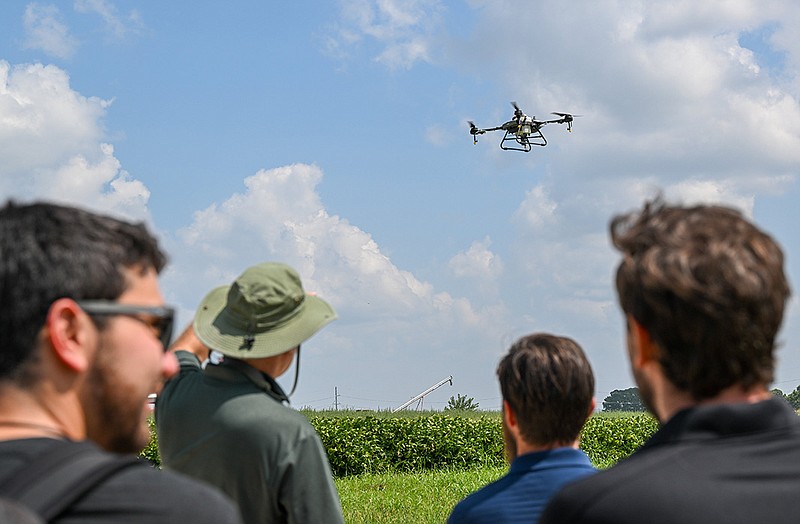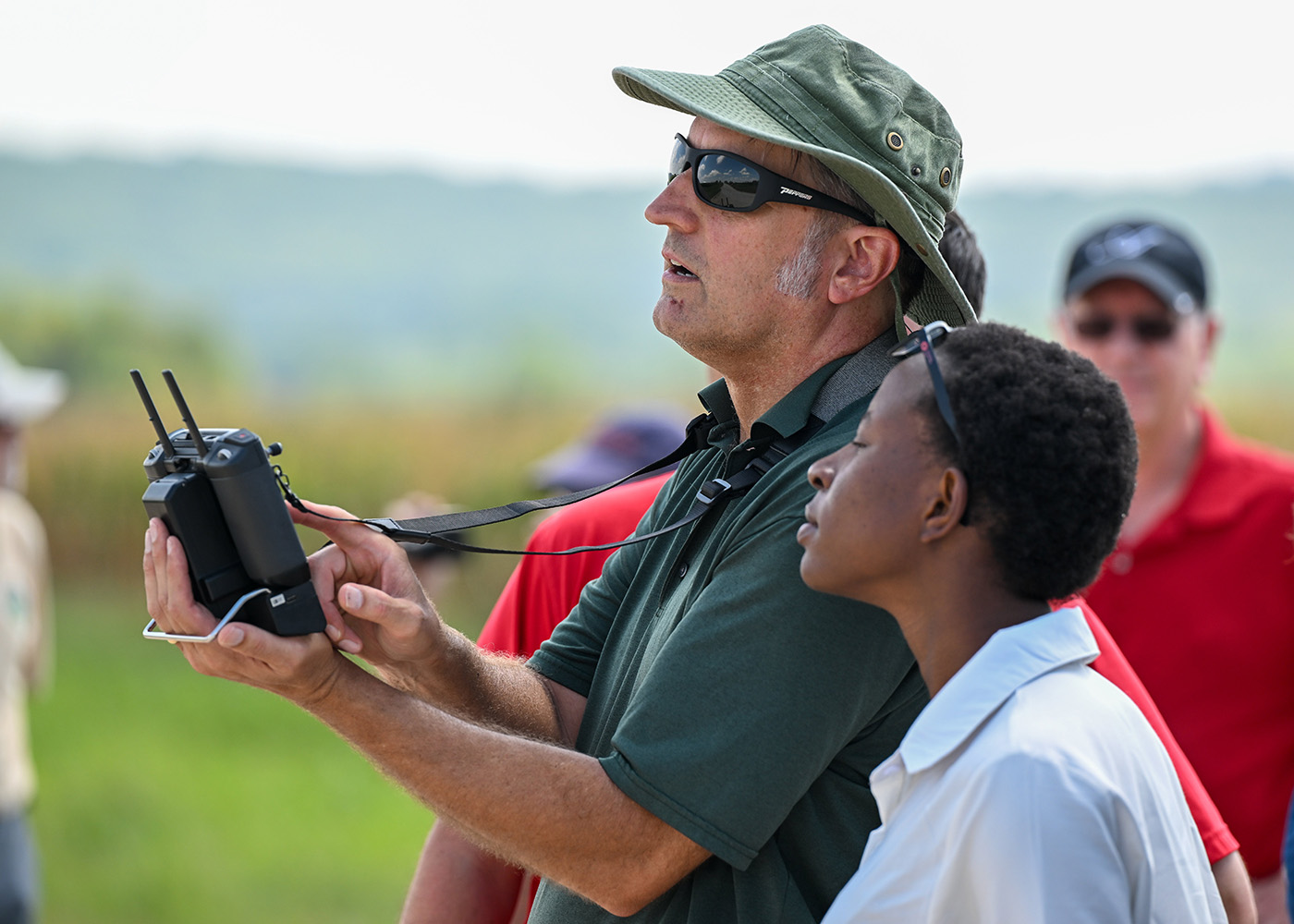FAYETTEVILLE -- As drones become more widely adopted in various industries, the University of Arkansas, Fayetteville is increasing its use of drones in research and education.
"About six, eight years ago, when there were few users, some people thought [drones] were a fad, but over time, more and more have seen this is not a flash in the pan," said Richard Ham, associate director of the Master of Science in Engineering Management and Operations Management.
As prices for drones have decreased, and awareness of uses for them has increased, drones have become more accessible, with businesses, researchers, and educators all diving into the possibilities.
The university conducted a drone demonstration Wednesday at Garland Farm, an experimental farm that aims to solve critical agricultural challenges, with students and faculty illustrating applications for drones in variegated disciplines, from architecture, engineering, and operations, to supply chain management and agriculture.
Numerous kindergarten to 12th-grade students from the area also came to see the possible uses of drones, and business and industry were represented, as well; for example, Joel M. Jones, president and chief pilot of Farmington's Drone Crop Services, brought one of his company's smaller drones to demonstrate.
"It weighs under 55 pounds, can fly in a lot of different environments, and can spray about 10 acres an hour," he said. "Most farms in Northwest Arkansas are 10 acres or less, with varied topology, so it can be difficult to get land rigs in, and we're replacing the man in the field spraying by hand wearing a backpack and PPE (personal protective equipment)."
"We can spray any pesticides that are legal to be sprayed from the air, and we're efficient getting into steep hillsides, for example," he said. "We can also disinfect artificial turf football and soccer fields."
Spraying fields with drones can make agriculture safer and more efficient, Ham said. "As a land-grant university, we serve the citizens of this state," and agricultural innovations are paramount in Arkansas, where "agriculture is so important."
Drone pilot is "definitely an expanding field," Jones said. "It looks like nationally we'll need about 10,000 remote pilots in agriculture to fill all the needs."
Trae Reed, recruitment and retention officer for the Arkansas Air National Guard, is trying to get more youth interested in careers with drones, both commercially and in the military.
"It's growing in the world, and we have a drone unit in Fort Smith," only an hour or so from Northwest Arkansas, he said. "We have people in Arkansas right now flying drones overseas -- it's a unique mission -- and we need to find people who are interested."
Drones can be used in agriculture for crop monitoring, yield prediction, and disease detection, according to the university. In addition, DroneUp and Zipline are delivery products from Walmart in Northwest Arkansas from several locations, and Ozark Electric is using a remote docking station to launch drones to inspect electrical infrastructure.
Chris Fink, founder and chief executive officer of Fayetteville-based UVT (Unmanned Vehicle Technologies), has been working with the university on drone technology for about six years and attended Wednesday to network and make more connections in the drone milieu.
He's long believed in the power of drones, seeing them do everything from making night-time bridge inspections infinitely easier to collecting interior images of restaurants to analyzing health of turf grass, he said. Police and transportation departments also use them for accident scene reconstruction and quick clearance of scenes following accidents.
Drones are at the intersection of education, training, technological innovation, and workforce development, a fact that has Mike Malone highly enthusiastic, the vice chancellor for economic development said Wednesday. "Industry is asking for this," and the university is a willing -- and able -- partner, which is "exciting."
"We're taking our knowledge and expertise to meet industry needs," he added. "It's a perfect example of seeing technology in action."
Aurelie M. Poncet, an assistant professor of precision agriculture, is working on a system to monitor nitrate levels in crops with drones in order for farmers to optimize production "very inexpensively," as drones she uses can be purchased for as little as a few hundred dollars, she said. "It's really, really cool and can make a big difference."
Farmers can fly over fields at any time with her system, "and they can get the information they need in less than 10 minutes," she said. "We collect data at 400 feet -- you can cover quite a bit of acreage in one [image] -- and it's very exciting."
As business, industry, and the military utilize drones more, it's incumbent upon universities to incorporate drone training, said Ham, an early adopter of drone technology. "We have to prepare students for the workforce."
And, often, it's students who raise new opportunities with drones to Ham, rather than the other way around, he said with a smile. "They've come up with so many creative ideas and even started businesses with" drones.
Emma Menio is working on her Ph.D. in Geosciences at the university, is a graduate assistant, and led one of Wednesday's drone demonstrations. She first gained drone experience while working on an archeology project in southern Utah mapping pre-colonial roads covered with vegetation.
A drone "was the perfect tool, and I got hooked after that," she said. Not only are drones highly useful, they're simply "fun, and it's a fun group of people to work with, too."
"With drones, you can see so much more than you can with just your eyes, it's easy to get a remote pilot license, and [drones] are relatively cheap," she said. "You can do comparative studies, too."
On Wednesday, she demonstrated a Lidar -- Light Detection and Ranging -- drone, which employs a remote sensing method used to examine the surface of the Earth, she said. "It can permeate through vegetation and hit the ground surface to see what the topography is."
She'd like to eventually work in government or science administration, but even if her professional duties don't involve regular drone usage, she won't turn away from the technology, she said. "I'd love to get my own drone and fly it around for fun."
Another UA-Fayetteville student experienced with drones is sophomore Ani Thyagarajan, who first gained exposure through Bentonville Schools Ignite -- a professional studies program that provides students with real, relevant learning experiences in collaboration with regional businesses, nonprofits, and industry professionals -- in 2019. He received his remote pilot license and began flying various drone missions, then -- as a high school senior -- interned with the Benton County sheriff's office.
He's continued there, where he uses drones regularly, and he's also a member of the ROTC on campus, hoping to enter the U.S. Space Force as an officer in 2026, he said. "My experience with drones got me into" joining Space Force.
Ham has U.S. Air Force and Department of Homeland Security experience, so he saw the possibilities of drones early, but initially drones were so expensive as to be impractical for most.
Recently, however, "any small business can afford one, which is a big step," and as drones are able to carry more weight, he expects a revolution in the shipping and logistics arena, he said. In the next five to ten years, there will be "drone corridors" that make shipping items faster, simpler, and cheaper, which "will be a game-changer, no doubt about it."
It can also be lifesaving, as drones can deliver needed medical supplies to remote areas, he said. For example, a drone can quickly deliver anti-venom to an individual who had been bitten by a venomous snake nowhere near any medical facility.
Eventually, drones could transport people, too, making humanity and work more efficient, he said. It's "dynamic change."
Of course, with more drones in the air, safety concerns increase, which is why the Federal Aviation Administration holds regular meetings and briefings, said Jamie Black, program manager for the FAA Safety Team based in Little Rock. "It's important to follow regulations to [avoid] accidents."
In fact, Black and others held a safety meeting Tuesday night in Bentonville, he said. "We had both drone and [general aviation] pilots there" to discuss the local airspace.
"Drones and their sophisticated sensors, such as LiDAR, thermal and multi-spectral cameras, and high-resolution mapping cameras, enable us to map and monitor the natural and built environment with greater precision and frequency than ever before," Jackson Cothren, director of the Center for Advanced Spatial Technologies at UA-Fayetteville, noted in a news release from the university. "We are still learning how to manage and effectively use the massive amounts of data generated by these systems."

